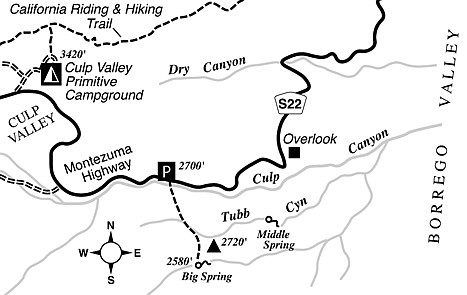 Facebook
Facebook
 X
X
 Instagram
Instagram
 TikTok
TikTok
 Youtube
Youtube
Big Spring, tucked in a tributary of Tubb Canyon on the west side of Borrego Valley, is one of the more reliable water producers in the Anza-Borrego Desert State Park. As such, it’s an important watering hole for local wildlife. Tracks on the sandy pathways leading to the spring show evidence of visits by coyotes, mountain lions, and bighorn sheep.
Unknown to most park visitors, Big Spring is quite easy to reach on foot — only a three-quarter mile walk from the nearest paved road. To get to the starting point, drive to mile 11.2 on Montezuma Highway (about halfway between roadside mile markers 11.0 and 11.5), around halfway down the long and twisting Montezuma Grade going from Ranchita to Borrego Springs. Park in the turnout along the north side of the highway. Take some liquid refreshment with you, since the water in the spring can’t be guaranteed as potable.
Walk due south across 400 yards of flat terrain, and cross over a gentle saddle. After January’s and February’s copious rainfall in these parts, you might see (by mid-March anyway) plenty of cactus blooms hereabouts. After the 400 yards you should pick up a trail that descends into a sandy wash — the head of Tubb Canyon. After about 200 yards downstream the trail leaves this wash and passes over a low saddle to the south. Big Spring lies beyond, in the bottom of Tubb Canyon’s south branch.
At the spring, the water gushes through tall thickets of seepwillow and thorny tangles of catclaw and mesquite — so it may be hard to reach the water with one’s hide intact. Small willows and cottonwoods raise their crowns above it all. Enhancing the scene is the massive presence of Pinyon Ridge, dotted with pinyon pines, rising to the south.
Before going back to the highway, try climbing the small hill (2720 feet elevation) east of the saddle you just passed over. This is one of the panoramic viewing sites used by volunteers during the Anza-Borrego Desert summer bighorn-sheep census.
This article contains information about a publicly owned recreation or wilderness area. Trails and pathways are not necessarily marked. Conditions can change rapidly. Hikers should be properly equipped and have safety and navigational skills. The Reader and Jerry Schad assume no responsibility for any adverse experience.


Big Spring, tucked in a tributary of Tubb Canyon on the west side of Borrego Valley, is one of the more reliable water producers in the Anza-Borrego Desert State Park. As such, it’s an important watering hole for local wildlife. Tracks on the sandy pathways leading to the spring show evidence of visits by coyotes, mountain lions, and bighorn sheep.
Unknown to most park visitors, Big Spring is quite easy to reach on foot — only a three-quarter mile walk from the nearest paved road. To get to the starting point, drive to mile 11.2 on Montezuma Highway (about halfway between roadside mile markers 11.0 and 11.5), around halfway down the long and twisting Montezuma Grade going from Ranchita to Borrego Springs. Park in the turnout along the north side of the highway. Take some liquid refreshment with you, since the water in the spring can’t be guaranteed as potable.
Walk due south across 400 yards of flat terrain, and cross over a gentle saddle. After January’s and February’s copious rainfall in these parts, you might see (by mid-March anyway) plenty of cactus blooms hereabouts. After the 400 yards you should pick up a trail that descends into a sandy wash — the head of Tubb Canyon. After about 200 yards downstream the trail leaves this wash and passes over a low saddle to the south. Big Spring lies beyond, in the bottom of Tubb Canyon’s south branch.
At the spring, the water gushes through tall thickets of seepwillow and thorny tangles of catclaw and mesquite — so it may be hard to reach the water with one’s hide intact. Small willows and cottonwoods raise their crowns above it all. Enhancing the scene is the massive presence of Pinyon Ridge, dotted with pinyon pines, rising to the south.
Before going back to the highway, try climbing the small hill (2720 feet elevation) east of the saddle you just passed over. This is one of the panoramic viewing sites used by volunteers during the Anza-Borrego Desert summer bighorn-sheep census.
This article contains information about a publicly owned recreation or wilderness area. Trails and pathways are not necessarily marked. Conditions can change rapidly. Hikers should be properly equipped and have safety and navigational skills. The Reader and Jerry Schad assume no responsibility for any adverse experience.
